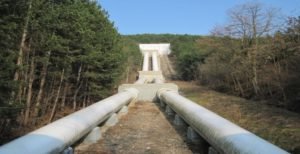Image source: stuffyoushouldknow.com
Geothermal energy is generated by drawing a steam of hot water into the earth’s surface. The steam of water produced can power the generator or heat up your home. During geothermal extraction, thermal energy produced determines the temperature of the matter informs of heat from the core to the surface.
Pros:
1. Environmentally friendly: Compared to oil and gas, geothermal energy is environmentally friendly and does not cause any pollution. No waste products produced during generation of geothermal power.
2. Home heating and cooling: Geothermal energy offer heating and cooling functions to homeowners. It results in significant savings. During winter, the earth surface is used as a solar panel where the heat pump absorbs the heat from the surface and in return use it to heat homes. At summer, the earth draws excess heat from the homes then distributes cool air to the homes.
3. Reduced costs: No fuel needed making it a cost-effective source of energy with fewer cost fluctuations. The new competitive method of installing the heat pump has reduced the cost of geothermal power extraction.
4. Available everywhere: The earth surface has a lot of free heat underneath the crust and this heat can be used to generate the power. Hot dry rocks heat sources are available everywhere in the world.
5. Low-temperature geothermal basins: With recent technology, sites with a low-temperature level of 80C to 150C can extract heat for electricity needs in the area.
6. Renewable source: Geothermal reservoirs are generally natural and you can exhaust them making it a renewable source of energy.
7. Meets energy demand: Compared to other energy sources like wind and solar, geothermal energy can meet baseload energy demands to make it a reliable source.
8. Technological advancements: Technological advancements have improved geothermal systems making resources more exploitable.
9. Little maintenance: It has minimal maintenance since only fewer parts are moved.
10. Small land footprint: Due to innovations in technology, substantial underground piping is required.
Cons:
1. High Investments: Geothermal power plant require a huge amount of economic resources. Building the exploration site is a bit expensive although the cost can be low compared to wind and solar energy plants.
2. Location-specific: Geothermal heat resources are widely spread and they vary from region to region. The intensity of heat depends on the distribution of geothermal basins in the area. Only regions close to the source receive heating and electricity.
3. Time-consuming: Before installing the geothermal plant, a lot of research is carried out to determine the feasibility of the site. This helps to determine the market conditions, developer specification and geological potential of the area.
4. Cause earthquake: Building large-scale geothermal plant may result in a small earthquake due to high-pressure water injection into the ground.
5. Environmental issues: Geothermal power extraction is associated with the emission of silica and sulfur dioxide which have a negative impact on the atmosphere. Greenhouse below the earth surface can also evaporate into the atmosphere.
6.
Sustainability issues: If geothermal reservoirs are not properly managed, it will lead to less energy supply. The reservoirs fluid should be replaced faster than it is used.
7.
Water requirement: A lot of water is required to produce geothermal energy.
8. Underground loops: Geothermal extraction damage underground loops and tree roots which can be very expensive to repair.
9. High electricity cost: A total cost of $2 to 7 million is spent to run 1mw geothermal plant. Heat pumps also need electricity to operate.
10. Distribution cost: Long distance transportation of geothermal energy through hot water increases distribution cost.



